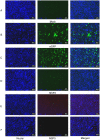Experimental pathways towards developing a rotavirus reverse genetics system: synthetic full length rotavirus ssRNAs are neither infectious nor translated in permissive cells
- PMID: 24019962
- PMCID: PMC3760874
- DOI: 10.1371/journal.pone.0074328
Experimental pathways towards developing a rotavirus reverse genetics system: synthetic full length rotavirus ssRNAs are neither infectious nor translated in permissive cells
Abstract
At present the ability to create rationally engineered mutant rotaviruses is limited because of the lack of a tractable helper virus-free reverse genetics system. Using the cell culture adapted bovine RV RF strain (G6P6 [1]), we have attempted to recover infectious RV by co-transfecting in vitro transcribed ssRNAs which are identical in sequence to the positive sense strand of each of the 11 dsRNA genomic segments of the RF strain. The RNAs were produced either from cDNAs cloned by a target sequence-independent procedure, or from purified double layered RV particles (DLPs). We have validated their translational function by in vitro synthesis of (35)S-labelled proteins in rabbit reticulocyte lysates; all 11 proteins encoded by the RV genome were expressed. Transfection experiments with DLP- or cDNA-derived ssRNAs suggested that the RNAs do not act independently as mRNAs for protein synthesis, once delivered into various mammalian cell lines, and exhibit cytotoxicity. Transfected RNAs were not infectious since a viral cytopathic effect was not observed after infection of MA104 cells with lysates from transfected cells. By contrast, an engineered mRNA encoding eGFP was expressed when transfected under identical conditions into the same cell lines. Co-expression of plasmids encoding NSP2 and NSP5 using a fowlpox T7 polymerase recombinant virus revealed viroplasm-like structure formation, but this did not enable the translation of transfected RV ssRNAs. Attempts to recover RV from ssRNAs transcribed intracellularly from transfected cDNAs were also unsuccessful and suggested that these RNAs were also not translated, in contrast to successful translation from a transfected cDNA encoding an eGFP mRNA.
Conflict of interest statement
Figures










Similar articles
-
Rapid production of recombinant rotaviruses by overexpression of NSP2 and NSP5 genes with modified nucleotide sequences.J Virol. 2024 Dec 17;98(12):e0099624. doi: 10.1128/jvi.00996-24. Epub 2024 Nov 4. J Virol. 2024. PMID: 39494903 Free PMC article.
-
Recombinant Rotaviruses Rescued by Reverse Genetics Reveal the Role of NSP5 Hyperphosphorylation in the Assembly of Viral Factories.J Virol. 2019 Dec 12;94(1):e01110-19. doi: 10.1128/JVI.01110-19. Print 2019 Dec 12. J Virol. 2019. PMID: 31619556 Free PMC article.
-
Further characterisation of rotavirus cores: Ss(+)RNAs can be packaged in vitro but packaging lacks sequence specificity.Virus Res. 2013 Dec 26;178(2):252-63. doi: 10.1016/j.virusres.2013.09.034. Epub 2013 Oct 1. Virus Res. 2013. PMID: 24091366 Free PMC article.
-
Plasmid-based reverse genetics for probing phosphorylation-dependent viroplasm formation in rotaviruses.Virus Res. 2021 Jan 2;291:198193. doi: 10.1016/j.virusres.2020.198193. Epub 2020 Oct 11. Virus Res. 2021. PMID: 33053412 Free PMC article. Review.
-
Replication and transcription of the rotavirus genome.Curr Pharm Des. 2004;10(30):3769-77. doi: 10.2174/1381612043382620. Curr Pharm Des. 2004. PMID: 15579070 Review.
Cited by
-
Re-Examining Rotavirus Innate Immune Evasion: Potential Applications of the Reverse Genetics System.mBio. 2022 Aug 30;13(4):e0130822. doi: 10.1128/mbio.01308-22. Epub 2022 Jun 14. mBio. 2022. PMID: 35699371 Free PMC article. Review.
-
Virulence-associated genome mutations of murine rotavirus identified by alternating serial passages in mice and cell cultures.J Virol. 2014 May;88(10):5543-58. doi: 10.1128/JVI.00041-14. Epub 2014 Mar 5. J Virol. 2014. PMID: 24599996 Free PMC article.
-
Rotavirus RNA chaperone mediates global transcriptome-wide increase in RNA backbone flexibility.Nucleic Acids Res. 2022 Sep 23;50(17):10078-10092. doi: 10.1093/nar/gkac738. Nucleic Acids Res. 2022. PMID: 36062555 Free PMC article.
-
Challenging the Roles of NSP3 and Untranslated Regions in Rotavirus mRNA Translation.PLoS One. 2016 Jan 4;11(1):e0145998. doi: 10.1371/journal.pone.0145998. eCollection 2016. PLoS One. 2016. PMID: 26727111 Free PMC article.
-
An Inhibitory Motif on the 5'UTR of Several Rotavirus Genome Segments Affects Protein Expression and Reverse Genetics Strategies.PLoS One. 2016 Nov 15;11(11):e0166719. doi: 10.1371/journal.pone.0166719. eCollection 2016. PLoS One. 2016. PMID: 27846320 Free PMC article.
References
-
- Estes MK, Kapikian AZ (2007) Rotaviruses. In: Knipe DM, Howley PM, editors. Fields Virology. 5th ed: Lippincott Williams & Wilkins/Wolters Kluwer, Philadelphia. 1917–1974.
-
- Tate JE, Burton AH, Boschi-Pinto C, Steele AD, Duque J, et al. (2012) 2008 estimate of worldwide rotavirus-associated mortality in children younger than 5 years before the introduction of universal rotavirus vaccination programmes: a systematic review and meta-analysis. The Lancet Infectious Diseases 12: 136–141. - PubMed
-
- Vesikari T, Matson DO, Dennehy P, Van Damme P, Santosham M, et al. (2006) Safety and Efficacy of a Pentavalent Human-Bovine (WC3) Reassortant Rotavirus Vaccine. New England Journal of Medicine 354: 23–33. - PubMed
-
- Ruiz-Palacios GM, Perez-Schael I, Velazquez FR, Abate H, Breuer T, et al. (2006) Safety and efficacy of an attenuated vaccine against severe rotavirus gastroenteritis. New England Journal of Medicine 354: 11–22. - PubMed
-
- SAGE (2009) Meeting of the immunization strategic advisory group of experts, April 2009 - conclusions and recommendations. Weekly Epidemiological Record 84: 220–235. - PubMed
Publication types
MeSH terms
Substances
Grants and funding
LinkOut - more resources
Full Text Sources
Other Literature Sources

